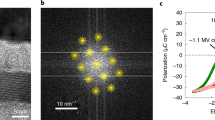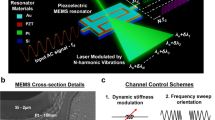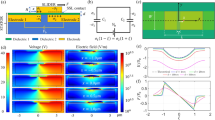Abstract
Many electronic systems depend on microelectromechanical system and nanoelectromechanical system resonators for frequency control applications such as clock signal generation and wireless communication. Hundreds of resonators with frequencies from 32 kHz to 6 GHz can be heterogeneously integrated with complementary metal–oxide–semiconductor circuits. However, heterogeneous integration creates large overheads—such as system size and power consumption—limiting the potential for dynamic spectrum use and frequency extension to centimetre- and millimetre-wave regimes. Here we report switchable nanoelectromechanical system resonators with wide spectrum coverage, which are based on hafnia–zirconia–alumina (Hf0.5Zr0.5O2–Al2O3) superlattice transducers. The superlattice structure, together with pulsed-poling-induced ferroelastic reorientation, enables large linear electromechanical coupling and high quality factor in lateral- and thickness-oriented bulk acoustic wave modes. The monolithic nanoelectromechanical system resonators offer frequencies of 0.4–17.3 GHz, frequency–quality products up to 4.04 × 1012 Hz and electromechanical couplings of 2.5%. Using a d.c. bias voltage to depolarize the transducers, we also show that the resonators can be switched off to their electromechanical noise floor, creating an on/off isolation of 37 dB.
This is a preview of subscription content, access via your institution
Access options
Access Nature and 54 other Nature Portfolio journals
Get Nature+, our best-value online-access subscription
$29.99 / 30 days
cancel any time
Subscribe to this journal
Receive 12 digital issues and online access to articles
$119.00 per year
only $9.92 per issue
Buy this article
- Purchase on Springer Link
- Instant access to full article PDF
Prices may be subject to local taxes which are calculated during checkout






Similar content being viewed by others
Data availability
The data that support the findings of this study are available from the corresponding author upon reasonable request.
References
Bereyhi, M. J. et al. Hierarchical tensile structures with ultralow mechanical dissipation. Nat. Commun. 13, 3097 (2022).
Kang, J. et al. On-chip intercalated-graphene inductors for next-generation radio frequency electronics. Nat. Electron. 1, 46–51 (2020).
Villanueva, L. G. et al. A nanoscale parametric feedback oscillator. Nano Lett. 11, 5054–5059 (2011).
Cha, J. & Daraio, C. Electrical tuning of elastic wave propagation in nanomechanical lattices at MHz frequencies. Nat. Nanotechnol. 13, 6–11 (2018).
Chen, C. et al. Graphene mechanical oscillators with tunable frequency. Nat. Nanotechnol. 8, 923–927 (2013).
Ruby, R. A snapshot in time: the future in filters for cell phones. IEEE Microw. Mag. 16, 46–59 (2015).
Nguyen, C. T. C. MEMS technology for timing and frequency control. IEEE Trans. Ultrason. Ferroelectr. Freq. Control 54, 251–270 (2007).
Pourkamali, S., Ho, G. K. & Ayazi, F. Low-impedance VHF and UHF capacitive silicon bulk acoustic-wave resonators—part II: measurement and characterization. IEEE Trans. Electron Devices 54, 2024–2030 (2007).
Bhugra, H. & Piazza, G. Piezoelectric MEMS Resonators (Springer, 2017).
Trolier-Mckinstry, S. & Muralt, P. Thin film piezoelectrics for MEMS. J. Electroceram. 12, 7–17 (2004).
Dubois, M. A. & Muralt, P. Properties of aluminum nitride thin films for piezoelectric transducers and microwave filter applications. Appl. Phys. Lett. 74, 3032–3034 (1999).
Hopcroft, M. A., Nix, W. D. & Kenny, T. W. What is the Young’s modulus of silicon? J. Microelectromech. Syst. 19, 229–238 (2010).
Mahon, S. The 5G effect on RF filter technologies. IEEE Trans. Semicond. Manuf. 30, 494–499 (2017).
Nathanson, H. C. & Wickstrom, R. A. A resonant-gate silicon surface transistor with high-Q band-pass properties. Appl. Phys. Lett. 84, 84–86 (1965).
Anderson, J., He, Y., Bahr, B. & Weinstein, D. Integrated acoustic resonators in commercial fin field-effect transistor technology. Nat. Electron. 5, 611–619 (2022).
Rawat, U., Bahr, B. & Weinstein, D. Analysis and modeling of an 11.8 GHz fin resonant body transistor in a 14 nm FinFET CMOS process. IEEE Trans. Ultrason. Ferroelectr. Freq. Control 69, 1399–1412 (2022).
Chen, H.-Y., Shih, P.-I., Li, M.-H. & Li, S.-S. 5V-bias CMOS-MEMS capacitive resonator with RM<5KΩ based on metal-insulator-metal (Mim) capacitor. In 2022 IEEE 35th International Conference on Micro Electro Mechanical Systems Conference (MEMS) 1042–1045 (IEEE, 2022).
Ledesma, E., Zamora, I., Yanez, J., Uranga, A. & Barniol, N. Single-cell system using monolithic PMUTs-on-CMOS to monitor fluid hydrodynamic properties. Microsyst. Nanoeng. 8, 76 (2022).
Hudeczek, R., Hager, E., Baumgartner, P. & Pretl, H. Performance analysis of resonant-fin transistors and their application in RF-circuit design. IEEE Access 10, 64388–64407 (2022).
Tian, D., Chen, P., Yang, X. & Chu, B. Thickness dependence of dielectric and piezoelectric properties from the surface layer effect of BaTiO3-based ceramics. Ceram. Int. 47, 17262–17267 (2021).
Martin, F., Muralt, P., Dubois, M.-A. & Pezous, A. Thickness dependence of the properties of highly c-axis textured AlN thin films. J. Vac. Sci. Technol. A 22, 361–365 (2004).
Nguyen, M. D., Dekkers, M., Vu, H. N. & Rijnders, G. Film-thickness and composition dependence of epitaxial thin-film PZT-based mass-sensors. Sens. Actuators A. Phys. 199, 98–105 (2013).
Yandrapalli, S. et al. Thin film devices for 5G communications. In 2021 IEEE 34th International Conference on Micro Electro Mechanical Systems (MEMS) 450–453 (IEEE, 2021).
Böscke, T. S., Müller, J., Bräuhaus, D., Schröder, U. & Böttger, U. Ferroelectricity in hafnium oxide thin films. Appl. Phys. Lett. 99, 102903 (2011).
Ghatge, M., Walters, G., Nishida, T. & Tabrizian, R. An ultrathin integrated nanoelectromechanical transducer based on hafnium zirconium oxide. Nat. Electron. 2, 506–512 (2019).
Cheema, S. S. et al. One nanometer HfO2-based ferroelectric tunnel junctions on silicon. Adv. Electron. Mater. 8, 2100499 (2022).
Hakim, F., Ghatge, M. & Tabrizian, R. Excitation of high-frequency in-plane bulk acoustic resonance modes in geometrically engineered hafnium zirconium oxide nano-electro-mechanical membrane. Appl. Phys. Lett. 117, 063502 (2020).
Hakim, F., Tharpe, T. & Tabrizian, R. Ferroelectric-on-Si super-high-frequency fin bulk acoustic resonators with Hf0.5Zr0.5O2 nanolaminated transducers. IEEE Microw. Wireless Compon. Lett. 31, 701–704 (2021).
Shiraishi, T. et al. Impact of mechanical stress on ferroelectricity in (Hf0.5Zr0.5)O2 thin films. Appl. Phys. Lett. 108, 262904 (2016).
Park, M. H. et al. Study on the degradation mechanism of the ferroelectric properties of thin Hf0.50.52Zr0.50.52O0.50.52 films on TiN and Ir electrodes. Appl. Phys. Lett. 105, 072902 (2014).
Park, M. H. et al. Understanding the formation of the metastable ferroelectric phase in hafnia-zirconia solid solution thin films. Nanoscale 10, 716–725 (2018).
Kim, H. J. et al. Grain size engineering for ferroelectric Hf0.5Zr0.5O2 films by an insertion of Al2O3 interlayer. Appl. Phys. Lett. 105, 192903 (2014).
Starschich, S. & Boettger, U. An extensive study of the influence of dopants on the ferroelectric properties of HfO2. J. Mater. Chem. C 5, 333–338 (2017).
Walters, G., Shekhawat, A., Moghaddam, S., Jones, J. L. & Nishida, T. Effect of in situ hydrogen plasma on the ferroelectricity of hafnium zirconium oxide films. Appl. Phys. Lett. 116, 032901 (2020).
Batra, R., Huan, T. D., Jones, J. L., Rossetti, G. & Ramprasad, R. Factors favoring ferroelectricity in hafnia: a first-principles computational study. J. Phys. Chem. C 121, 4139–4145 (2017).
Lederer, M. et al. On the origin of wake-up and antiferroelectric-like behavior in ferroelectric hafnium oxide. Phys. Status Solidi Rapid Res. Lett. 15, 2100086 (2021).
Riedel, S., Polakowski, P. & Müller, J. A thermally robust and thickness independent ferroelectric phase in laminated hafnium zirconium oxide. AIP Adv. 6, 095123 (2016).
Tharpe, T., Zheng, X., Feng, P. X. & Tabrizian, R. Resolving mechanical properties and morphology evolution of free-standing ferroelectric Hf0.5Zr0.5O2. Adv. Eng. Mater. 23, 2101221 (2021).
Zheng, X. Q. et al. High quality factors in superlattice ferroelectric Hf0.5Zr0.5O2 nanoelectromechanical resonators. ACS Appl. Mater. Interfaces 14, 36807–36814 (2022).
Jiang, Q., Lee, H. J., Kim, G. H. & Hwang, C. S. The inlaid AI2O3 tunnel switch for ultrathin ferroelectric films. Adv. Mater. 21, 2870–2875 (2009).
Kirbach, S., Kühnel, K. & Weinreich, W. Piezoelectric hafnium oxide thin films for energy-harvesting applications. In 2018 IEEE 18th International Conference on Nanotechnology (IEEE-NANO) 1–4 (IEEE, 2019).
Mart, C. et al. Piezoelectric response of polycrystalline silicon-doped hafnium oxide thin films determined by rapid temperature cycles. Adv. Electron. Mater. 6, 1901015 (2020).
Starschich, S., Schenk, T., Schroeder, U. & Boettger, U. Ferroelectric and piezoelectric properties of Hf1–xZrxO2 and pure ZrO2 films. Appl. Phys. Lett. 110, 182905 (2017).
Xu, F. et al. Domain wall motion and its contribution to the dielectric and piezoelectric properties of lead zirconate titanate films. J. Appl. Phys. 89, 1336–1348 (2001).
Damjanovic, D. in The Science of Hysteresis Vol. 3 (eds. Mayergoyz, I. & Bertotti, G.) 337–465 (Elsevier, 2005).
Liu, J., Liu, S., Yang, J. Y. & Liu, L. Electric auxetic effect in piezoelectrics. Phys. Rev. Lett. 125, 197601 (2020).
Dutta, S. et al. Piezoelectricity in hafnia. Nat. Commun. 12, 7301 (2021).
Rawat, U., Anderson, J. & Weinstein, D. Large-signal behavior of ferroelectric micro-electromechanical transducers. Preprint at https://arxiv.org/abs/2304.05975 (2023).
Guo, Q., Cao, G. Z. & Shen, I. Y. Measurements of piezoelectric coefficient d33 of lead zirconate titanate thin films using a mini force hammer. J. Vib. Acoust. 135, 011003 (2013).
Giovannini, M., Yazici, S., Kuo, N. K. & Piazza, G. Apodization technique for spurious mode suppression in AlN contour-mode resonators. Sens. Actuators A Phys. 206, 42–50 (2014).
Ghatge, M. & Tabrizian, R. Dispersion-engineered guided-wave resonators in anisotropic single-crystal substrates—part I: concept and analytical design. IEEE Trans. Ultrason. Ferroelectr. Freq. Control 66, 1140–1148 (2019).
Ghatge, M., Ramezani, M. & Tabrizian, R. Dispersion-engineered guided-wave resonators in anisotropic single-crystal substrates—part II: numerical and experimental characterization. IEEE Trans. Ultrason. Ferroelectr. Freq. Control 66, 1149–1154 (2019).
Martin, F. et al. Shear mode coupling and tilted grain growth of A1N thin films in BAW resonators. In IEEE Ultrasonics Symposium 1, 333–336 (IEEE, 2005).
Dragoman, M. et al. HfO2-based ferroelectrics applications in nanoelectronics. Phys. Status Solidi Rapid Res. Lett. 15, 2000521 (2021).
Aldrigo, M. et al. Microwave applications of zirconium-doped hafnium oxide ferroelectrics: from nanoscale calculations up to experimental results. In 2020 IEEE/MTT-S International Microwave Symposium (IMS) 520–523 (IEEE, 2020).
Aldrigo, M. et al. Low-voltage permittivity control of coplanar lines based on hafnium oxide ferroelectrics grown on silicon. IEEE Access 7, 136686–136693 (2019).
Mart, C. et al. Piezoelectric response of polycrystalline silicon-doped hafnium oxide thin films determined by rapid temperature cycles. Adv. Electron. Mater. 6, 1901015 (2020).
Acknowledgements
We would like to thank the University of Florida Nanoscale Research Facility cleanroom staff for fabrication support and T. Hancock for supporting this project and helpful technical discussions. T.T., F.H. and R.T. acknowledge financial support from the Defense Advanced Research Projects Agency (DARPA) through the Young Faculty Award (grant D19AP00044) and National Science Foundation (NSF) through the CAREER award (grant ECCS-1752206). E.H. and H.K. acknowledge financial support from the University of Florida through the Research Opportunity Seed Fund (ROSF).
Author information
Authors and Affiliations
Contributions
T.T. designed, fabricated and measured the NEMS resonators. T.T. and F.H. fabricated and characterized the superlattice transducer. E.H. performed the TEM characterization of the superlattice. H.K. and R.T. supervised the project and provided guidance throughout the process. All authors participated in analysing the results and contributed to writing the paper. All authors have given approval to the final version of the paper.
Corresponding author
Ethics declarations
Competing interests
The authors declare no competing interests.
Peer review
Peer review information
Nature Electronics thanks Ming-Huang Li, Mina Rais-Zadeh and the other, anonymous, reviewer(s) for their contribution to the peer review of this work.
Additional information
Publisher’s note Springer Nature remains neutral with regard to jurisdictional claims in published maps and institutional affiliations.
Supplementary information
Supplementary Information
Supplementary Sections 1–12, Figs. 1–15 and Tables 1–3.
Rights and permissions
Springer Nature or its licensor (e.g. a society or other partner) holds exclusive rights to this article under a publishing agreement with the author(s) or other rightsholder(s); author self-archiving of the accepted manuscript version of this article is solely governed by the terms of such publishing agreement and applicable law.
About this article
Cite this article
Tharpe, T., Hershkovitz, E., Hakim, F. et al. Nanoelectromechanical resonators for gigahertz frequency control based on hafnia–zirconia–alumina superlattices. Nat Electron 6, 599–609 (2023). https://doi.org/10.1038/s41928-023-00999-9
Received:
Accepted:
Published:
Issue Date:
DOI: https://doi.org/10.1038/s41928-023-00999-9
This article is cited by
-
A ferroelectric-gate fin microwave acoustic spectral processor
Nature Electronics (2024)
-
Giant energy storage and power density negative capacitance superlattices
Nature (2024)
-
Three-dimensional acoustic resonators for massively scalable spectral processors
Nature Electronics (2024)



